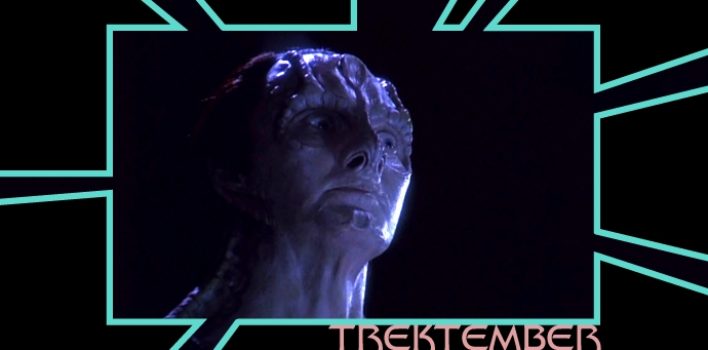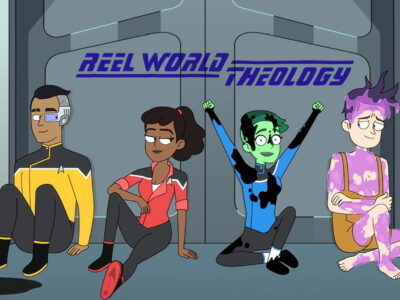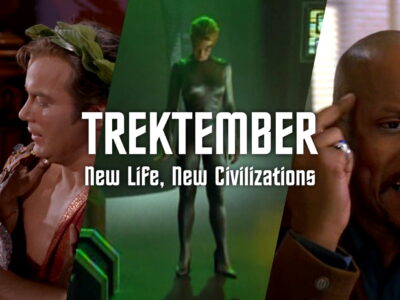Trektember: Empok Nor
There isn’t any objective “up” or “down” in space. Which is why, objectively, it makes no sense that O’Brien and his salvage crew’s approach to Empok Nor feels so disquieting. The abandoned Cardassian station looks almost exactly like the familiar stomping grounds of Deep Space Nine—except for the fact that the station is listing heavily from its usual axis, looking for all the world like a sinking ship; its pylons curved in on itself from the docking ring like grasping claws instead of beckoning fingers.
Logically and intellectually, this shouldn’t change anything about the way we experience this scene. But narratively, we immediately intuit a difference between Empok Nor and the comfortable halls of Deep Space Nine; its orientation, its lighting, the music, the lack of activity, even the unnerving similarity to what we’re accustomed, all turn this into what might be the Star Trek franchise’s most effective haunted house. But the terror here isn’t the derelict station’s lazy angle. It’s not the traps left behind by Cardassians as they departed. The terror doesn’t even really come from the Third Battalion soldiers left in stasis aboard.
No, as with any good ghost story, the true terror is what they brought with them.
A Comforting Mistrust
O’Brien: I’m glad you’re here.
(Garak responds with a look of confusion)
O’Brien: What’s the matter?
Garak: It’s just that lately I’ve noticed that everyone seems to trust me. It’s quite unnerving. I’m still trying to get used to it.
Though played for laughs, Garak and O’Brien’s banter about the crew’s sudden trust of the Cardassian tinker-tailor-soldier-spy actually illuminates the rest of the episode in a somewhat melancholy way: Garak is isolated from Deep Space Nine‘s crew and population by a mistrust of the mystery surrounding his purpose and goals. Aside from his regular lunch with Dr. Bashir (which is, it seems, less a friendship and more a regular verbal chess game), Garak doesn’t connect with anyone aboard. This is almost certainly a lonely fact of Garak’s existence, but he has come to accept it; more so, to be unnerved by its absence.
At the core of this sad reality are the tribes that the characters have chosen. The three main groups of people in Star Trek: Deep Space Nine put a lot of their identity into the society of which they’re a part. Members of the Federation have built their identity around the United Federation of Planets; Bajorans have built their identity around the pain they suffered as Bajorans; and Garak has built his identity around being a Cardassian.
But aboard Empok Nor, Garak is infected by a substance which amplifies this tribalism, turning him from a plain, simple tailor into a hardened, paranoid killer; stalking the hallways of the space station in search of his prey and taunting Chief O’Brien with every step. He’s lost himself in his tribalism. His love for his people has turned into a hatred for everyone else.
O’Brien: You look different.
Garak: How so?
O’Brien: That’s not the face of a tailor.
Garak: I’m not a tailor. Not for the moment, anyway.
We have our tribes, too. No matter how welcoming or open to outsiders we try to be, we’ll always be more allied with one group than with others; this is normal and not a bad thing. Tribes aren’t bad; it becomes bad when we put our groups over and above glorifying God and loving the people He called us to love.
When it becomes bad is when our love for our tribes becomes tribalism. All of us are susceptible to its infection; it lies in wait behind statements that make sense, beneath weasely words and thoughtless stereotypes, around the corners of “just joking” and past the walls of “being comfortable.” We can have tribalism for our nationality, our ancestry, our job, our lifestyle—even our faith.
And when we give in to this pernicious, creeping hatred of “the other,” we become someone we don’t recognize (and wouldn’t like if we did). We do things we wouldn’t have chosen and don’t really like.
An Amplified Xenophobia
Tribalism can start out in the guise of harmless allegiance, but it goes further and runs deeper. One way or another, we are forced to hate another; we stop listening and begin to hurt those we love. Our tribalism may not end in physical violence (though sometimes it can), but it often turns to careless name-calling and flippant disregard for others. It strikes at the core of the imago dei, and—allowed long enough to fester—will eventually drive a wedge between us and everyone else.
The worst part is, our tribalism doesn’t even welcome us into its waiting arms. There’s always “one more thing,” one more proof that you’re “part of us,” one more shibboleth to prove your devotion, until one day you’ve distanced yourself and torpedoed your relationship with everyone you thought you were working alongside. Like Garak, we are cast aside and forgotten. Like the Cardassian soldiers, we are ignored until we are useful.
Tribalism promises that we’ll be part of an in-crowd, but it never allows us that joy. Even if it doesn’t drive us to murder, it kills us on the inside.
And there’s no room for it in the Christian life.
Not through fighting, or overpowering, or outmaneuvering our opponent. Like Chief O’Brien, we win by doing what an engineer does: building and fixing. We win by counting the lives of others as more valuable than our own. We win by seeking and praying for healing, and by rooting out hatred wherever it is in our hearts.
In short, we win by following Christ, who laid His life down on this sideways-orbiting space station known as Earth; who died to save those who were different from Him, even those who hated Him; who died to give us the power to resist tribalism and live in love.
In a world of hatred, Jesus is the cure.







